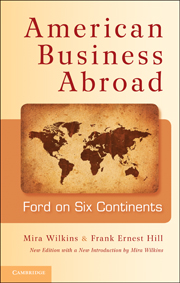Book contents
- Frontmatter
- Contents
- List of Illustrations
- Preface
- Introduction to the New Edition
- Introduction to the First Edition
- 1 First Venture
- 2 Probing for Markets
- 3 Model T: Triumph and Fable
- 4 The Alchemy of War
- 5 Steps in Expansion
- 6 The Sun Never Sets
- 7 Prosperity and Frustration
- 8 The Missionary Spirit
- 9 The Best-Laid Plans
- 10 Marriage of Convenience
- 11 Time of Desperation
- 12 A World Disturbed
- 13 Extreme of Nationalism
- 14 The British Empery
- 15 On Both Sides of World War II
- 16 The Crippled Phoenix
- 17 The New Company
- 18 Manufacturing for World Markets: From Dagenham to Geelong
- 19 New Times, New Faces, New Policies
- Appendices
- Bibliographical Essay
- Notes
- Index
- Titles in the series
- Plate section
10 - Marriage of Convenience
Published online by Cambridge University Press: 05 June 2012
- Frontmatter
- Contents
- List of Illustrations
- Preface
- Introduction to the New Edition
- Introduction to the First Edition
- 1 First Venture
- 2 Probing for Markets
- 3 Model T: Triumph and Fable
- 4 The Alchemy of War
- 5 Steps in Expansion
- 6 The Sun Never Sets
- 7 Prosperity and Frustration
- 8 The Missionary Spirit
- 9 The Best-Laid Plans
- 10 Marriage of Convenience
- 11 Time of Desperation
- 12 A World Disturbed
- 13 Extreme of Nationalism
- 14 The British Empery
- 15 On Both Sides of World War II
- 16 The Crippled Phoenix
- 17 The New Company
- 18 Manufacturing for World Markets: From Dagenham to Geelong
- 19 New Times, New Faces, New Policies
- Appendices
- Bibliographical Essay
- Notes
- Index
- Titles in the series
- Plate section
Summary
The Communist regime in Russia had made a decision to enter the field of motor car production and proposed to erect a plant “for the manufacture of 100,000 automobiles annually,” as their representative in the United States, Valery I. Meshlauk, wrote to Edsel Ford on May 6, 1929. “Owing to the high standard of your machine,” he stated in the same letter, “and the popularity it enjoys at the present time in Soviet Russia, we are considering the manufacture at such a plant of your Model A automobile, with such improvements as may be introduced in the future.”
He asked for the Ford Motor Company's assistance, and got it. On May 31 a contract was signed between the Supreme Council of National Economy of the USSR and the Amtorg Trading Corporation on the one hand and the Ford Motor Company on the other. It provided for a Model A plant in Russia and the sale to the Union of Soviet Socialist Republics of 72,000 Ford vehicles in the next four years. It was an extension of Ford activity abroad that confirmed Henry Ford's expectations as to the possibilities of his car in foreign trade.
The richest capitalist in the world had made a compact with a government as yet unrecognized by the United States, which was also the proclaimed arch foe of capitalism and dedicated to its destruction. To understand this action it is necessary to consider briefly the relationship of the Ford company with Russia, beginning almost a decade prior to the communist revolution.
- Type
- Chapter
- Information
- American Business AbroadFord on Six Continents, pp. 208 - 227Publisher: Cambridge University PressPrint publication year: 2011

